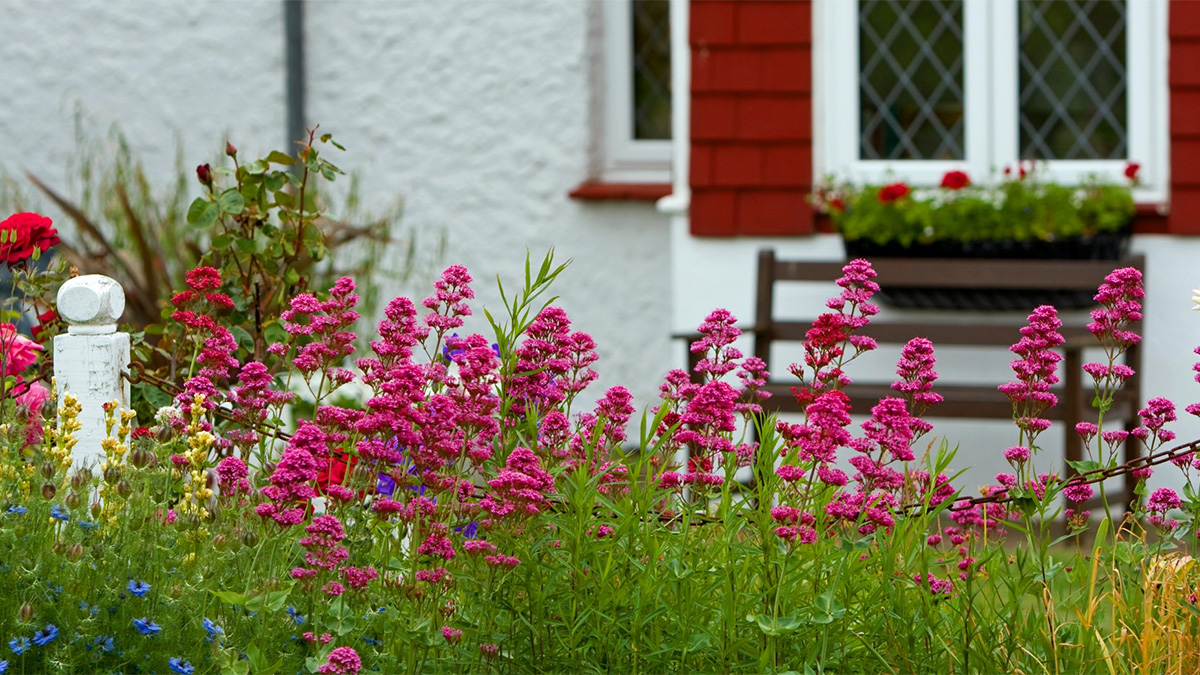Essential Plants for a Classic Cottage Style Garden

A classic cottage garden blends beauty, color, and a touch of wildness in a way that feels both romantic and relaxed. With the right mix of perennials, herbs, climbers, and flowering shrubs, you can create a space that feels timeless and abundant. This guide introduces the essential plants that bring a cottage garden to life, no matter the size of your space.
Related: Creating a Classic Cottage Garden on a Budget
Key features of a cottage garden plant palette
Cottage gardens are defined by their relaxed, overflowing plantings filled with layers of color, texture, and fragrance. Instead of neat rows, plants are allowed to intermingle naturally, creating a lush and inviting feel. A mix of perennials, annuals, self-seeding flowers, herbs, and shrubs contributes to a sense of abundance and timeless charm.
Old-fashioned favorites that define the style
Roses are perhaps the most iconic plant in a cottage garden, especially English or shrub varieties that bloom repeatedly and carry strong fragrance. Delphiniums and foxgloves provide vertical accents, with tall spires of blue, purple, or white that bring drama and height to the back of a border. Hollyhocks are another essential, often placed against fences or walls where their towering stems create a nostalgic backdrop.
Peonies add elegance with their full, richly textured blooms that appear in late spring to early summer. Their large flowers and glossy foliage make them a favorite for both beds and bouquets. These classic plants anchor the garden and reflect the romantic heritage of the style.
Fragrant herbs and edible additions
Lavender offers both structure and scent, lining paths or filling in spaces with silvery foliage and purple blooms. Thyme and oregano make excellent ground covers, softening edges and offering culinary value. Chives and sage contribute soft flowers and attract pollinators while serving double duty in the kitchen.
Mint is best kept in containers to prevent spreading, but it adds a lovely, fresh aroma when brushed by passing feet. These herbs not only enhance the sensory experience but also attract beneficial insects and promote a healthy ecosystem.
Self-seeding annuals for effortless charm
Cosmos are light and airy, with delicate stems that dance in the breeze and bloom through summer into fall. Nigella, also known as love-in-a-mist, brings soft blue or white flowers nestled in feathery foliage and self-seeds readily in the right conditions. Calendula adds vibrant orange or yellow blooms and can improve soil health over time.
Poppies lend a natural, whimsical element to the garden, offering everything from bold red blooms to soft pastel tones depending on the variety. These annuals help fill in spaces, return year after year with minimal effort, and add movement and spontaneity to garden beds.
Climbing plants for arches, trellises, and walls
Clematis is a versatile climber that pairs beautifully with roses, covering trellises, fences, or obelisks with large star-shaped blooms. Sweet peas are beloved for their fragrance and charming flowers, thriving in cooler weather and offering delightful early-season color. Wisteria creates dramatic cascades of lavender or white blossoms, perfect for pergolas and archways.
Climbing roses add vertical interest and floral abundance, softening walls or climbing over gates and arbors. These climbers bring a strong sense of enclosure and romance to the cottage garden layout.
Foliage and fillers for balance and softness
Lady’s mantle has scalloped green leaves and sprays of chartreuse flowers that offer a cooling effect among brighter blooms. Cranesbill geraniums are hardy and long-flowering, making them excellent fillers for spaces between taller perennials. Lamb’s ear provides velvety silver foliage that contrasts beautifully with green leaves and pastel flowers.
Hostas and alchemilla are great for partially shaded spots and help knit together borders with their broad leaves and soft shapes. These plants contribute to the layered texture that defines the cottage garden look.
Small shrubs and structural plants
Hydrangeas provide seasonal color with their large blooms and give volume to planting beds. Boxwood, when used sparingly, can lend formality and structure without dominating the informal style. Spirea offers light, fine-textured foliage and delicate pink or white flowers in early summer.
Butterfly bush adds height and attracts pollinators, blooming for an extended period and offering a fountain-like shape that fits well with other cottage-style favorites. These shrubs round out the design and provide reliable anchors through the seasons.
Tips for planting and maintaining the look
When planting, aim for relaxed groupings with repeated patterns that draw the eye naturally across the garden. Allowing plants to self-seed and intermingle adds authenticity and softness, while some basic structure helps prevent chaos. Regular deadheading, occasional dividing, and leaving room for natural reseeding keeps the garden both abundant and balanced.
Conclusion
Cottage gardens thrive on variety, layering, and a little bit of freedom. By combining traditional blooms, fragrant herbs, and soft-textured fillers, you can create a garden that’s full of charm and personality. With thoughtful planting and a touch of patience, your garden will grow into a space that looks and feels beautifully effortless.
Related: The Joy of Chaos Gardening: How to Plant Without Overthinking
